What's New
Displaying results 3271 - 3280 of 4052
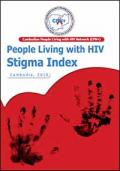
Resource | Publications,
Stigma and discrimination surrounding HIV/AIDS pose critical barriers to prevention, treatment, care and support programs. There is currently little reliable data or documentation relating to stigma and discrimination against people living with HIV (PLHIV) in Cambodia.
The study was carried out in five selected provinces where a total number of 394 PLHIV were interviewed, 71% of whom are females and 29% of whom are males. About 80% of respondents were aged 30-49 years. The gender and age profiles of respondents maybe reflective of the large proportion of respondents who belonged to self-help groups and not of the PLHIV population in general. There was a low level of schooling (75% received either no schooling or primary schooling only) and >70% of respondents were working as farmers or sellers. The study methodology included a quantitative method based on the global HIV Stigma Index questionnaire and a qualitative method which involved focus group discussions and key informant interviews.

Resource | Publications,
While Pacific Island Countries and Territories (PICTs) have been collecting HIV and AIDS case data for many years, 2009 was the first year in which routine data on other sexually transmitted infections (STIs) were collected and reported. Eleven PICTs with access to laboratory testing facilities (either in country or by referral) reported on three STIs; chlamydia, gonorrhoea and syphilis.
STIs are an important cause of morbidity in adults and also infants born to infected parents. While many chlamydia infections are asymptomatic, if left untreated, both chlamydia and gonorrhoea infection can cause pelvic inflammatory disease, ectopic pregnancy and infertility. They may also cause conjunctivitis and pneumonia in newborns. Syphilis can cause miscarriage, stillbirth and congenital syphilis. The latter may cause irreversible damage to cardiovascular and nervous system of the newborn infected child. Amongst both men and women, HIV transmission is facilitated by the presence of any STI, including asymptomatic chlamydia.
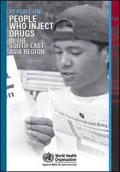
Resource | Publications,
Since the 1990s the majority of countries in the South-East Asia Region have experienced a significant injecting drug use problem, accompanied by explosive rates of HIV at some sites. Over time the national response has increasingly been to implement various harm reduction interventions to reduce the HIV prevalence and address the health needs of people who inject drugs (PWID). This assessment examines the current situation of HIV and injecting drugs and of the national responses. The focus is on countries with a high and medium burden of illicit drug injecting. In most of these countries PWID are either HIV infected or have the potential for being infected. The countries reviewed are Bangladesh, India, Indonesia, Maldives, Myanmar, Nepal and Thailand.
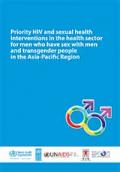
Resource | Publications,
In essence, the present document describes the priority health sector interventions recommended to achieve universal access for the prevention, treatment, care and support of HIV and sexually transmitted infections among MSM in the broader perspective of male sexual health. It summarizes key policy and technical recommendations developed by WHO related to each priority health sector intervention. It guides the selection and prioritization of interventions for HIV prevention, treatment, care and support. Finally, it directs readers to key resources of WHO and other organizations containing the best available information on the health sector response to HIV among MSM.
Relying on a rigorous background of male sexual health and strategic information, this document is, to the extent possible, based on scientific evidence and programmatic experience in prevention, care, support and treatment of HIV, as well as male sexual health. It is also intended to be as specific as possible for its implementation in the context of Asia and the Pacific, addressing a broad audience including public health decision-makers, national AIDS programme managers, health care providers, community-based organization managers, MSM living with and affected by HIV, and development agencies.

Resource | Publications,
Since their inception in 2003, UNDP’s Asia-Pacific Human Development Reports have been stimulating a lively dialogue within the region on a range of important issues. Prepared by experts from Asia and the Pacific, the Reports present an authentic account of human development progress, possibilities, and challenges in this vibrant and fastgrowing region.
This year’s Report focuses on the critical question of advancing gender equality, as seen through the prism of women’s unequal power, voice, and rights. Despite the region’s many economic gains, the Report chronicles how in many instances women across the region continue to be held back and disadvantaged. Even as many women have benefited from their countries’ improved education, health, and prosperity, they continue to face barriers to the same opportunities available to men.

Resource | Publications,
Since 2004, an ESCAP/ADB/UNDP partnership has regularly produced reports carefully tracking progress of the Asia and Pacific region towards the Goals. They have developed a consistent monitoring system for judging whether countries and subregions are on-track or off-track to meet the indicators for the 2015 Goals – presenting the results in a series of distinctive colour-coded ‘traffic-light’ charts. Each of the reports has focused on a particular theme, such as Millennium Development Goals (MDG) consistent national development policies or institutional reforms to make the development process fairer and more inclusive, or the impact of the food, fuel and financial crises on the likely achievement of the goals.
The report Paths to 2015 emphasises the inter-relationships between MDGs by identifying some overall priorities and opportunities that countries can consider for achieving all the goals. Then it focuses specifically on three areas: hunger and food security; health and basic services – areas where the Asia-Pacific region as a whole appears to be falling short; and on improvement of basic infrastructure which is often neglected but is critical if the region is to achieve the MDGs.

Resource | Publications,
This annual 2010 progress report on "HIV/AIDS in the South-East Asia Region" presents key achievements in prevention and control of HIV in the Region and highlights areas where further work is needed.
The Region is home to nearly 3.5 million people living with HIV/AIDS of whom nearly half are likely to be co-infected with TB. A large number of new HIV infections are still occurring each year which places HIV prevention at the top of the agenda for national AIDS programmes.
Overall, good progress has been made in reducing heterosexual transmission of HIV through 100% condom use programmes and community-based peer led interventions. There has also been noteworthy success in ensuring safe blood transfusion services averting hundreds of thousands of infections every year. Just a few years ago, access to treatment was a dream for most people living with HIV in the Region. Today, more than half a million people living with HIV in the South-East Asia Region are on treatment, living longer and contributing to society.
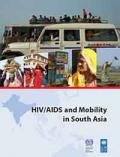
Resource | Publications,
For the millions who seek greater employment and economic opportunities migration is an increasingly attractive option. Migrants not only comprise an essential component of the workforce in more economically developed countries, but also provide significant contributions to the national economies of their home countries.
Migrants, however, are often exploited, marginalized, and stigmatized throughout the migration process. As mobility within South Asian countries and migration within the region and abroad continues to grow, care must be made to ensure that migrants’ rights are protected.
This study provides a synthesis of current migration trends and the HIV situation in seven countries of South Asia, examining the HIV situation of migrants within the context of gender, national and international migration patterns, policies and legislation. It is our hope that it provides a comprehensive reference tool for future policy, programmes and advocacy, and ultimately, contributes to the protection of migrants’ rights throughout the whole migration cycle.
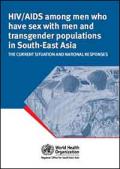
Resource | Publications,
In 2009, a situation assessment was conducted among men who have sex with men (MSM) and transgender (TG) populations in South-East Asia. The aim was to improve our understanding of HIV and sexually transmitted infections (STI), the risk behaviours, as well as the nature and extent of the national responses to the HIV epidemics among these populations. The data collected and analysed will inform current and future action in the South-East Asia Region (SEAR) to address the health needs of MSM and TG populations. This desk-based assessment used multiple data sources to review the situation in nine countries of SEAR – Bangladesh, India, Indonesia, Maldives, Myanmar, Nepal, Sri Lanka, Thailand and Timor-Leste.

Resource | Publications,
Data is available for new diagnoses of Human Immunodeficiency Virus (HIV) infections from all Pacific Island Countries and Territories (PICTs) except Papua New Guinea (PNG) for the year to December 2009 and to December 2008 for PNG, Australia and New Zealand. In 2008, there were 5,169 new HIV diagnoses reported in Pacific Island Countries and Territories (PICTs), and diagnoses in PNG accounted for 5,084 or 98.4% of notifications. Excluding PNG, the annual number of new HIV diagnoses reported in PICTs was 85 cases in 2008 and 82 in 2009.





